import random
import numpy as np
import matplotlib.pyplot as plt
from typing import *
from qiskit_aer import AerSimulator
import qiskit.quantum_info as qi
from qiskit.quantum_info import Statevector, Operator
from qiskit.visualization import plot_histogram
from qiskit import QuantumCircuit
sim = AerSimulator()
from util import zero, one, Pretty
QI: Mixed States and Density Matrices#
In this notebook, we’ll introduce density matrices. Density matrices enable us to describe mixed states which are statical ensembles of quantum states. Mixed states can arise due to decoherence/noise or due to partial measurement.
Quantum Computation and Quantum Information: Chapter 2.4, Nielsen and Chuang
https://qiskit.org/textbook/ch-quantum-hardware/density-matrix.html
Mixed States#
A collection
where \(|v_i\rangle\) are quantum state vectors and \(\sum_{i=1}^n p_i = 1\) is a mixed state. We can interpret a mixed state as a classic probability distribution over quantum state vectors. Thus we can also call a mixed state an ensemble.
Examples#
We’ll unpack the definition with a few examples.
Example 1#
We’ll first look at a mixed state over a single qubit system to contrast an ensemble and superposition.
X1 = [zero, one]
ps1 = [0.5, 0.5]
ensemble1 = [(p, x) for p, x in zip(ps1, X1)]
ensemble1
[(0.5,
Statevector([1.+0.j, 0.+0.j],
dims=(2,))),
(0.5,
Statevector([0.+0.j, 1.+0.j],
dims=(2,)))]
samples = random.choices(
[str(x) for p, x in ensemble1],
weights=[p for p, x in ensemble1],
k=1000
)
plt.hist(samples); plt.title("Ensemble 1")
Text(0.5, 1.0, 'Ensemble 1')
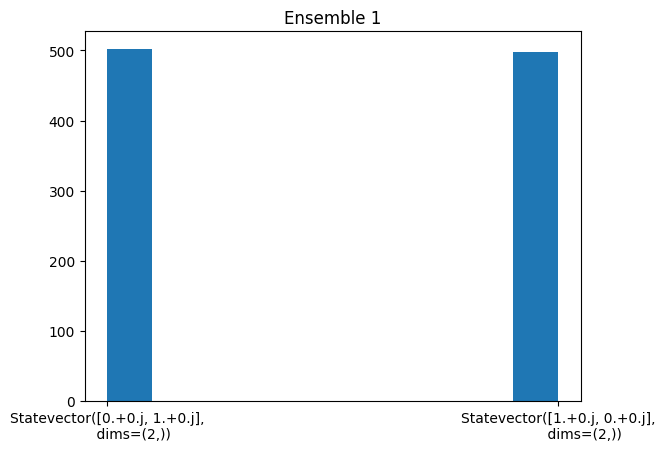
The mixed state given by ensemble 1 is either \(|0\rangle\) or \(|1\rangle\) with 50% probability.
The mixed state is different from the state \(\frac{1}{\sqrt{2}}(|0\rangle + |1\rangle)\) that is an equal superposition of \(|0\rangle\) and \(|1\rangle\) with 100% probability.
Upon measurement, we still obtain that \(\frac{1}{\sqrt{2}}(|0\rangle + |1\rangle)\) gives either \(|0\rangle\) or \(|1\rangle\) with 50% probability.
Example 2#
Our next example looks at a mixed state over a single qubit involving 3 components.
# Can overspecify
X2 = [zero, one, 1/np.sqrt(2)*zero + 1/np.sqrt(2)*one]
ps2 = [0.2, 0.5, 0.3]
ensemble2 = [(p, x) for p, x in zip(ps2, X2)]
ensemble2
[(0.2,
Statevector([1.+0.j, 0.+0.j],
dims=(2,))),
(0.5,
Statevector([0.+0.j, 1.+0.j],
dims=(2,))),
(0.3,
Statevector([0.70710678+0.j, 0.70710678+0.j],
dims=(2,)))]
samples = random.choices(
[str(x) for p, x in ensemble2],
weights=[p for p, x in ensemble2],
k=1000
)
fig, axes = plt.subplots(1, 1); plt.hist(samples)
plt.setp(axes.get_xticklabels(), rotation=10, horizontalalignment='right');
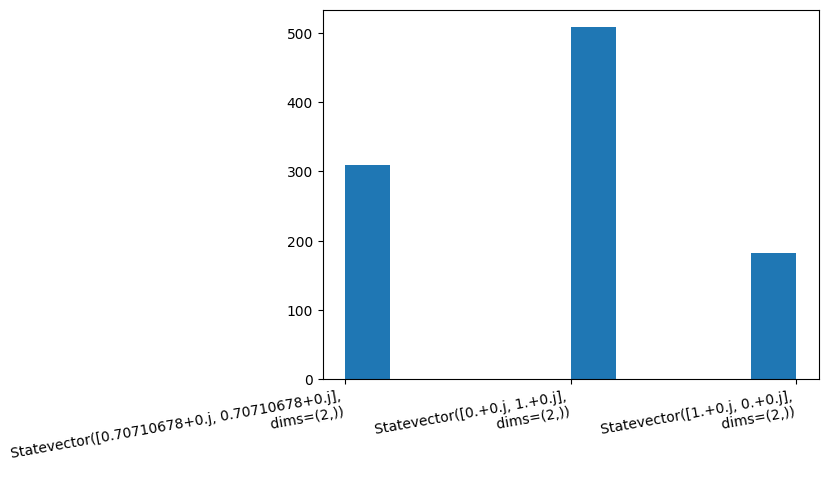
The mixed state given by ensemble 2 is either \(|0\rangle\) (30%), \(|1\rangle\) (50%), or \(\frac{1}{\sqrt{2}}(|0\rangle + |1\rangle)\) (20%).
Upon measurement, we obtain \(|0\rangle\) with probability 35% and \(|1\rangle\) with 65% probability.
Example 3#
Our final example introduces one over a multi-qubit system.
# Can underspecify (missing one ^ zero)
X3 = [zero ^ zero, one ^ one, zero ^ one]
ps3 = [0.3, 0.2, 0.5]
ensemble3 = [(p, x) for p, x in zip(ps3, X3)]
ensemble3
[(0.3,
Statevector([1.+0.j, 0.+0.j, 0.+0.j, 0.+0.j],
dims=(2, 2))),
(0.2,
Statevector([0.+0.j, 0.+0.j, 0.+0.j, 1.+0.j],
dims=(2, 2))),
(0.5,
Statevector([0.+0.j, 1.+0.j, 0.+0.j, 0.+0.j],
dims=(2, 2)))]
samples = random.choices(
[str(x) for p, x in ensemble3],
weights=[p for p, x in ensemble3],
k=1000
)
fig, axes = plt.subplots(1, 1); plt.hist(samples)
plt.setp(axes.get_xticklabels(), rotation=10, horizontalalignment='right');
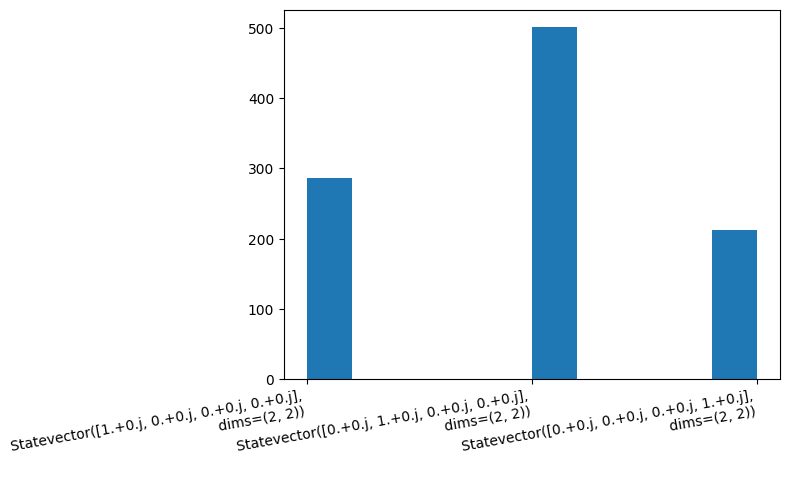
The mixed state given by ensemble 3 is either \(|00\rangle\) (30%), \(|11\rangle\) (20%), or \(|01\rangle\) (50%).
Mixed States vs. Pure States#
The state of a quantum system given by an ordinary quantum state vector is called a pure state.
Motiviating Mixed States#
Mixed states can arise due to decoherence/noise or due to partial measurement.
Situation 1: Decoherence/Noise#
qc = QuantumCircuit(1, 1)
if np.random.rand() < 0.5: # Suppose our hardware is faulty/noisy
qc.x(0) # 50% of the time, we flip
else:
qc.id(0) # 50% of the time, we don't do anything
qc.measure(0, 0)
qc.draw(output="mpl", style="iqp")

counts = {'0': 0, '1': 1}
for i in range(1024):
qc = QuantumCircuit(1, 1)
if np.random.rand() < 0.5:
qc.x(0)
else:
qc.id(0)
qc.measure(0, 0)
state = sim.run(qc, shots=1).result()
for k, v in state.get_counts().items():
counts[k] += v
plot_histogram(counts, title='Faulty Gates')
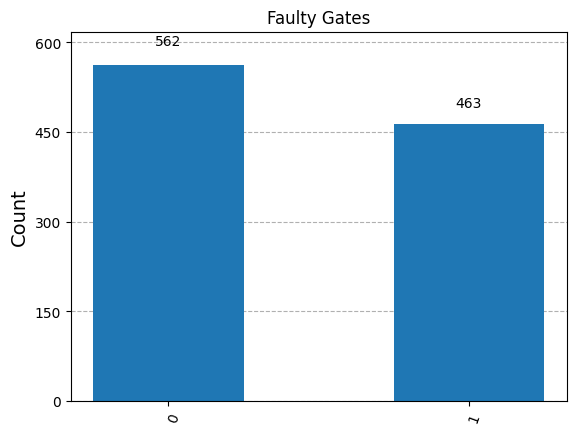
Situation 2: Partial Measurement#
Consider the following entangled state.
entangled = 1/np.sqrt(2)*(zero ^ zero) + 1/np.sqrt(2)*(one ^ one)
entangled.draw("latex")
Question#
What can we say about the state of qubit 0 if we only measure qubit 1?
Answer#
Let’s reason through this by running an experiment.
# Step 1: Prepare a measurement circuit
qc = QuantumCircuit(2, 1)
qc.initialize(entangled)
qc.measure(1, 0)
qc.draw(output="mpl", style="iqp")
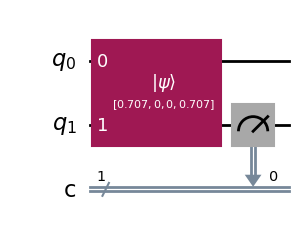
# Step 2: Perform the measurement
state = sim.run(qc, shots=1024).result()
plot_histogram(state.get_counts(), title='Qubit 1 Results')
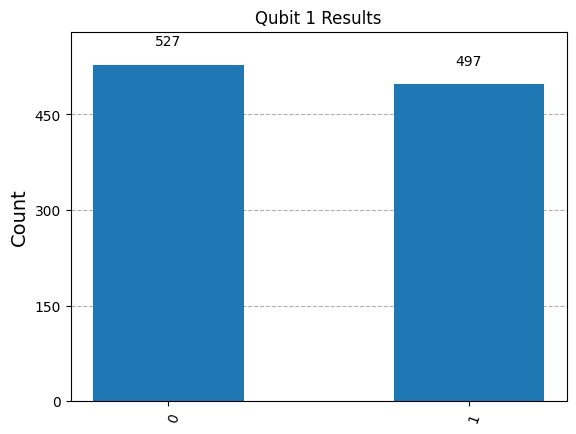
Analysis#
After running the experiment, we see that qubit 1 is \(|0\rangle\) 50% of the time and \(|1\rangle\) 50% of the time.
Moreover, our 2-qubit system was entangled $\( \frac{1}{\sqrt{2}}|00\rangle + \frac{1}{\sqrt{2}}|11\rangle \,. \)$
If qubit 0 is \(|0\rangle\), then qubit 1 is \(|0\rangle\). Similarly, if qubit 0 is \(|1\rangle\), then qubit 0 is \(|0\rangle\).
However, measurement forces us to observe either \(|0\rangle\) or \(|1\rangle\) for qubit 1 with some probability, which by entanglement, forces this probability onto qubit \(0\).
We have recreated the mixed state given by ensemble 1!
Density Matrix#
A density matrix provides an alternative characterization of mixed states and generalizes the notion of a quantum state vector.
Definition#
Let \(\{ (p_1, |v_1\rangle), \dots, (p_n, |v_n\rangle) \}\) be an ensemble. A density matrix \(\rho\) is defined as
where \(|v_i\rangle \langle v_i|\) is an outer product.
Aside: Outer Product#
Pretty(np.outer(np.array([1+1j, 1-1j, 2j]), np.array([1+1j, 1-1j])))
def ensembleToDensmat(ensemble: list[Tuple[float, Statevector]]) -> qi.DensityMatrix:
return qi.DensityMatrix(sum([p * np.outer(x, x) for (p, x) in ensemble]))
Examples#
ensemble1
[(0.5,
Statevector([1.+0.j, 0.+0.j],
dims=(2,))),
(0.5,
Statevector([0.+0.j, 1.+0.j],
dims=(2,)))]
rho1 = ensembleToDensmat(ensemble1)
rho1.draw("latex")
X15 = [1/np.sqrt(2) * zero + 1/np.sqrt(2)*one]
ps15 = [1.0]
ensemble15 = [(p, x) for p, x in zip(ps15, X15)]
rho15 = ensembleToDensmat(ensemble15)
rho15.draw("latex")
ensemble2
[(0.2,
Statevector([1.+0.j, 0.+0.j],
dims=(2,))),
(0.5,
Statevector([0.+0.j, 1.+0.j],
dims=(2,))),
(0.3,
Statevector([0.70710678+0.j, 0.70710678+0.j],
dims=(2,)))]
rho2 = ensembleToDensmat(ensemble2)
Pretty(rho2)
ensemble3
[(0.3,
Statevector([1.+0.j, 0.+0.j, 0.+0.j, 0.+0.j],
dims=(2, 2))),
(0.2,
Statevector([0.+0.j, 0.+0.j, 0.+0.j, 1.+0.j],
dims=(2, 2))),
(0.5,
Statevector([0.+0.j, 1.+0.j, 0.+0.j, 0.+0.j],
dims=(2, 2)))]
rho3 = ensembleToDensmat(ensemble3)
rho3.draw("latex")
Observation 1: Sum of the diagonal is always 1#
sum(np.diag(rho1)), sum(np.diag(rho2)), sum(np.diag(rho3))
(np.complex128(1+0j),
np.complex128(0.9999999999999999+0j),
np.complex128(1+0j))
Aside: Trace#
Let
be a square matrix.
Then
is the trace of a matrix.
np.trace(np.array([[1.0, 0.2], [0.3, 1.0]]))
np.float64(2.0)
np.trace(rho1), np.trace(rho2), np.trace(rho3)
(np.complex128(1+0j),
np.complex128(0.9999999999999999+0j),
np.complex128(1+0j))
Observation 1 more formally#
Let \(\text{diag}\) obtain the diagonal of a matrix. Then
Observation 2: Density matrix is Hermitian#
Every density matrix is a Hermitian matrix, i.e.,
print(np.allclose(rho1, np.conjugate(rho1).transpose()))
print(np.allclose(rho2, np.conjugate(rho2).transpose()))
print(np.allclose(rho3, np.conjugate(rho3).transpose()))
True
True
True
Observation 2 more formally#
Recall
Moreover, \(\overline{x_i \overline{x_j}} = \overline{x_i} x_j\).
Thus
Observation 3: Non-zero non-diagonal entries measures “quantumness”#
# No superposition between |0> or |1>
print("Ensemble", ensemble1)
print("Purity", rho1.purity())
rho1.draw("latex")
Ensemble [(0.5, Statevector([1.+0.j, 0.+0.j],
dims=(2,))), (0.5, Statevector([0.+0.j, 1.+0.j],
dims=(2,)))]
Purity (0.5+0j)
# Superposition between |0> or |1>
print("Ensemble", ensemble2)
print("Purity", rho2.purity())
rho2.draw("latex")
Ensemble [(0.2, Statevector([1.+0.j, 0.+0.j],
dims=(2,))), (0.5, Statevector([0.+0.j, 1.+0.j],
dims=(2,))), (0.3, Statevector([0.70710678+0.j, 0.70710678+0.j],
dims=(2,)))]
Purity (0.5899999999999999+0j)
Density Matrix Formulation of Quantum Computation#
We reformulate quantum computation using density matrices. This includes
reformulating the quantum state representation,
unitary evolution, and
measurement.
Quantum State Representation#
Every quantum state vector \(|v\rangle\) maps to the ensemble \(\{(1, |v\rangle)\}\)
v = 1/np.sqrt(2)*zero + 1/np.sqrt(2)*one
v.draw("latex")
qi.DensityMatrix(v).draw("latex")
Unitary Evolution#
The equivalent evolution of a density matrix \(\rho_{start} = |\psi\rangle \langle \psi|\) by \(U\) is given by
Recall: Quantum state vector evolution#
Given a quantum state vector \(|\psi\rangle\) and a unitary transformation \(U\), the result of applying \(U\) was \(U|\psi\rangle\).
# Construct circuit
qc = QuantumCircuit(2)
qc.h(0)
qc.cx(0, 1)
qc.draw(output="mpl", style="iqp")

# Corresponding unitary transformation
U = Operator(qc)
U.draw("latex")
print("Final state calculated with unitary evolution ...")
start = zero ^ zero
final = start.evolve(U)
final.draw("latex")
Final state calculated with unitary evolution ...
print("Final density matrix calculated with density matrix evolution ...")
qi.DensityMatrix(start).evolve(U).draw("latex")
Final density matrix calculated with density matrix evolution ...
print("Do unitary evolution and density matrix evolution match?", np.allclose(qi.DensityMatrix(start).evolve(U), qi.DensityMatrix(final)))
Do unitary evolution and density matrix evolution match? True
Measurement#
Let \(\{ \Pi_m \}_m\) be a complete set of measurement operators where \(m\) refers to the outcome so that it satisfies
Then the probability of obtaining outcome \(m\) after measuring is
The state of the system after measurement is
def measure_outcome(rho: qi.DensityMatrix, M_m: np.ndarray) -> Tuple[float, qi.DensityMatrix]:
# Probability of measuring m
p_m = np.trace(np.conjugate(M_m.transpose()) @ M_m @ rho.data)
# Resulting state after m
rho_p = (M_m @ rho.data @ np.conjugate(M_m.transpose())) / p_m
return p_m, rho_p
Example: Bell State#
We’ll check that the reformulation of measurement matches on the Bell state. First, we recall the entangling circuit that created the Bell state.
qc.draw(output="mpl", style="iqp")

(zero ^ zero).evolve(qc).draw("latex")
rho = qi.DensityMatrix(qc)
rho.draw("latex")
Recall that our measurement operators for partially measuring the first qubit (\(|q_0\rangle\)) were
\(\Pi_{*0} = |00\rangle\langle 00| + |10\rangle\langle 10|\) and
\(\Pi_{*1} = |01\rangle\langle 01| + |11\rangle\langle 11|\).
zz = zero ^ zero; zo = zero ^ one; oz = one ^ zero; oo = one ^ one
Pi0s = np.outer(zz, zz) + np.outer(oz, oz) # Pi0s only observes 1st qubit, and we get 0
Pi1s = np.outer(zo, zo) + np.outer(oo, oo) # Pi1s only observes 1st qubit, and we get 1
Pretty(Pi0s + Pi1s)
We’ll check the result of measuring \(|q_0\rangle\) and obtaining \(0\).
p_0, rho_0 = measure_outcome(rho, Pi0s)
print("probability |0>", p_0)
print("resulting density matrix")
# Note that we can express measurement of partial states
Pretty(rho_0)
probability |0> (0.4999999999999999+0j)
resulting density matrix
Similarly, we’ll check the result of measuring \(|q_0\rangle\) and obtaining \(1\).
p_1, rho_1 = measure_outcome(rho, Pi1s)
print("probability |1>", p_1)
print("resulting density matrix")
# Note that we can express measurement of partial states
Pretty(rho_1)
probability |1> (0.4999999999999999+0j)
resulting density matrix
Summary#
Introduced mixed states and density matrices, which are fundamental abstractions in QIS.
We Reformulated the unitary evolution of quantum states in terms of density matrices.
